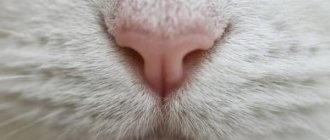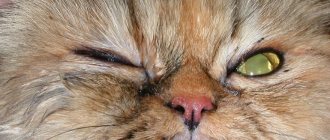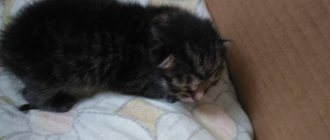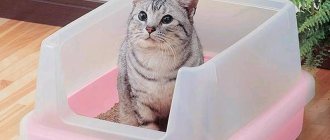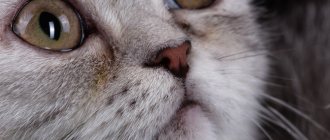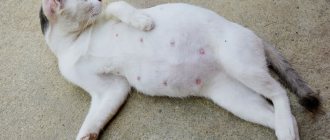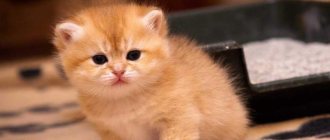11398Pavel
1
If an animal has nasal discharge, then the pet urgently needs treatment. Pus from a cat's nose can form due to allergies, a virus, or mechanical damage. You can find out what caused the snot from your veterinarian.
Pus from the nose of a kitten or an adult cat can be of a different nature.:
- Serous;
- Mucous;
- Mucopurulent;
- Purulent;
- Bloody;
- Bloody-purulent.
© shutterstock
If a cat has pus flowing from its nose, which prevents it from breathing and changes its color to yellow or green, then the pet should be taken to the doctor immediately. Yellow discharge most often indicates a bacterial infection in your pet. If they have a yellowish tint, then the pet is infected with a viral infection.
Causes
Pus from the nose
Diseases in which pus is discharged from the nose are divided into contagious and non-contagious.
The following are considered contagious:
- Herpes (rinotracheitis);
- Calicivirus;
- Cat flu;
Among the diseases of non-contagious etiology, the following most often develop:
- chronic diseases and colds;
- foreign bodies;
- congenital anomalies;
- tumors.
The causes of diseases, clinical symptoms, methods of diagnosis, treatment and prevention are not the same. Let's consider each disease separately.
Herpes (rhinotracheitis)
Herpes
The disease occurs among unvaccinated cats when kept in crowded conditions, unbalanced feeding in nurseries or shelters. Sick kittens die 10-14 days after the first signs appear. Those who have recovered become a reservoir of infection. There is a high probability of transplacental infection. The owner brings the virus into the apartment.
In addition to nasal discharge and cough, stomatitis, conjunctivitis with subsequent ulceration of the cornea, and mouth breathing develop. Constipation occurs and pregnant women abort. In the chronic course of the disease, panophthalmitis develops and the cat goes blind. An accurate diagnosis is established in the clinic.
The treatment is developed by a veterinarian. Prevention consists of timely vaccination, bringing living conditions and feeding into compliance with standards. If a cat refuses to eat for a long time, it is fed through a nasoesophageal tube. If signs of dehydration are detected, droppers with plasma substitutes are placed.
Nasoesophageal tube
When the cat begins to feed on its own, the veterinarian prescribes wet canned food or soaked granules.
Be sure to read:
A kitten's eyes are festering: normal or pathological, reasons, what to do at home, medications
Calicivirus
Ulcerative glossitis with calcivirosis.
In terms of symptoms, etiology, and pathogenesis, the viral disease resembles Herpes. A cough occurs and bronchopneumonia develops.
Distinctive features are ulcerative stomatitis and the absence of ulcerations on the cornea. Lameness appears suddenly, but disappears spontaneously after a few days. The treatment strategy and prevention are the same as for Herpes.
Cat flu
Polyvalent vaccine
Often Herpes and Calicivirus affect a pet at the same time. The disease was called cat flu. When making a diagnosis, attention is paid to the presence of signs of both diseases. A complex vaccine against calicivirus, rhinotracheitis and panleukopenia reliably protects against infection.
Cat flu is not dangerous to humans.
Treatment of cats
Once on the nasal mucosa, the virus penetrates the cells of the body, causing the cells to die. This is how inflammation begins. Also, general deterioration and fever are caused by viruses that have entered the bloodstream.
For the successful recovery of your furry pet, comprehensive treatment and proper care are necessary. The veterinarian will prescribe treatment based on the general condition of the patient. Experts do not recommend taking various medications on your own. This can only worsen the patient's condition.
In addition to taking special medications, the following recommendations will be useful:
- Isolation of a sick animal from healthy ones;
- Mandatory disinfection of the place where the sick pet lies;
- Drink warmly and avoid hypothermia;
- Cleaning the nose and eyes with antiseptics daily;
- If you refuse to eat, you need to force-feed the patient to avoid liver lipidosis (accumulation of fat);
- Gentle, liquid food: fish, meat, cereals and milk;
- The use of vitamin preparations, for example: Gamavit;
- Use of immunostimulating drugs: Imunofan, Fosprenil, Salmozan;
- Complex therapy includes the use of antiviral drugs: Acyclovir, Lysine, Gamapren;
- Antibiotics should be used if there is a manifestation of secondary infections, for example: Flemoxin, Sumamed, Cefazolin.
If you treat your cat correctly and follow all the recommendations of a professional, the animal’s condition will improve in 8-10 days.
The disease rhinotracheitis leads to a decrease in immunity. This leads to various negative consequences:
- The chronic stage is dangerous for the development of pneumonia, intestinal atony, damage to the nervous system, subsequent exacerbations of the disease, and the development of secondary infections;
- An advanced form of the disease can lead to damage to the eyeballs so that they have to be removed;
- In particularly severe cases, the disease leads to the death of the animal. Most of all, this threatens kittens and young individuals due to weak immunity;
- More than 80% of animals remain carriers of the infection after recovery.
Thus, a cat that has had rhinotracheitis is a source of infection for its kittens. The virus infects the animal's uterus. Therefore, miscarriages, various pathologies and deformities in newborns most often occur with infected cats. The virus is excreted in feces and urine for quite a long time, for 1.5 years.
Chronic diseases and colds
Rhinitis occurs as a symptom of exacerbation of the following permanent diseases:
- diabetes;
- urolithiasis disease;
- renal pathologies.
Too frequent bathing leads to hypothermia and reflex swelling of the mucous membrane. Ventilating rooms freshens the air, however, cats cannot tolerate drafts and become hypothermic. In hot weather, you should not leave your pet in a room with air conditioning running, otherwise he will catch a cold.
If the disease is caused by hypothermia, and the pet’s health is satisfactory, use dual-use drops - Maxidin or Anandin. Drugs intended for humans should not be used without the approval of a veterinarian.
What to do if your cat's nose is festering
As a rule, a complex treatment of the cat is carried out, aimed at normalizing the respiratory function and general condition of the animal.
The following is used in treatment:
- antibacterial, antiparasitic agents in injections, tablets, drops;
- antifungal drugs;
- immunomodulators;
- homeopathy remedies;
- physiotherapeutic procedures;
- alternative medicine.
Congenital anomalies
Spontaneous selection leads to the birth of offspring predisposed to rhinitis. Sometimes kittens are born with a deviated nasal septum.
Hypothermia or a reaction to odors leads to reflex swelling of the mucous membrane and rhinitis. Atopic dermatitis occurs in predisposed cats over one year of age. This is a reaction to dust, smoke and odors. Along with a runny nose, cats develop cough, conjunctivitis, and skin diseases.
Be sure to read:
The cat does not drink water: reasons, daily intake, what to do, is it dangerous, how to force the animal to drink
Congenital anomalies are incurable. However, with a successfully developed therapeutic strategy, exacerbations can be stopped.
A cat's nose is festering: the main reasons
Nasal suppuration is caused by increased activity of pyogenic pathogenic microflora. This is the main reason for the appearance of profuse purulent nasal discharge.
Causes of nasal suppuration in cats:
- viral, bacterial, parasitic infections;
- mycoses (fungal diseases);
- respiratory diseases (otitis, rhinitis, rhinotracheitis, inflammation of the eustachian tube);
- purulent, catarrhal conjunctivitis;
- trauma, mechanical damage to the nasal cavity;
- presence of foreign objects in the nose;
- inflammatory processes, infection of the mucous membrane;
- chronic allergies (food, non-food);
- decreased resistance, immune defense;
- congenital defects of the upper respiratory tract;
- dental diseases;
- pathological neoplasms in the nasal cavity and other parts of the respiratory tract;
- nasopharyngeal, nasal polyps;
- unsuccessful operations on ENT organs;
- exhaustion, weakening of the body.
Abundant gray-green cloudy purulent discharge from the nasal cavity of a cat, accompanied by wheezing, coughing, sneezing, indicates the development of serious diseases (panleukopenia, leukemia, peritonitis). Nasal suppuration is noted with calcivirosis, chlamydia, herpes virus infection, severe helminthic infestation, rhinotracheitis, toxoplasmosis, viral pneumonia, strepto-staphylococcal infection.
Important! The risk group includes small kittens, weakened animals, street animals, cats kept in groups in unfavorable conditions, and unvaccinated individuals.
A cat’s nose can also fester if there are wounds on the lobe, the lesions in which pathogenic flora has entered, causing acute, chronic inflammation.
Why does pus flow from the eyes?
In a cat, purulent eye discharge is usually accompanied by profuse lacrimation, constant squinting, painful reaction of the affected organ to light, redness, deterioration in general health (lethargy, decreased motor activity, problems with sleep, complete or partial refusal to eat). This problem may occur due to:
Conjunctivitis
- Inflammation of the conjunctiva (the thin mucous membrane lining the outer surface of the eyeball and the inner area of the eyelids) of bacterial origin.
- Inflammation of the ciliated edge of the eyelids (blepharitis), which is essentially a severe form of conjunctivitis. This disease can be superficial (the inflammatory process does not affect the deep layers of the eyelid) and deep (the ciliary roots and meibomian glands are affected).
- Contact with a foreign body in the eye.
- Infections of viral, fungal and bacterial origin.
Symptoms accompanying eye suppuration depend on the underlying disease. Information about them is presented in the table:
Blepharitis
| Diseases and conditions that provoke the discharge of pus from the eyes | Reason for development | Clinical picture (in addition to organ putrefaction) | |
| Bacterial conjunctivitis | Bacteria |
| |
| Foreign body entry | Mote, dust, dirt |
| |
| Blepharitis | Bacteria, viruses, fungi, parasites, mechanical damage |
| |
| Infections | Viral | Viruses |
|
| Bacterial (mycoplasmosis, chlamydia) | Bacteria |
| |
| Fungal (coccidioidomycosis) | Fungi |
| |
Sphinx's eyelids turn upside down
Some breeds, particularly Sphynxes, are prone to eye infections. This is due to their predisposition to the development of chronic conjunctivitis due to inversion of the eyelids. The eyelashes scratch the ocular surface of these animals, causing increased tear production and inflammation. Blepharitis is most often detected in representatives of the Persian and Burmese breeds.
Foreign bodies
When foreign materials enter the nose, inflammation and irritation may develop around them. Sometimes foreign material can be seen during rhinoscopy. In some cases, foreign objects can be removed from the nose using grasping instruments or rinsing. To rinse the nose of an animal under anesthesia, a liquid (saline solution) is injected. Sometimes visual examination methods: CT or MRI are required to detect foreign material.
Diagnostic methods
As discussed above, various methods are used to diagnose the cause of nasal abnormalities. A complete examination for nasal disorders includes:
- MRI or CT - these highly effective visual diagnostic methods can better distinguish the details of the nasal cavity than x-rays.
- Rhinoscopy is an examination of the nasal mucosa (the outermost layer) using a rhinoscope.
- A biopsy of tissue from the nasal cavity for histological examination (where a histologist examines the tissue under a microscope) and microbiological culture.
These procedures are performed under anesthesia, so additional baseline blood tests are often required to ensure the absence of systemic disease. If systemic diseases are present, it may be necessary to change the drugs used for anesthesia.
- Complete clinical analysis to evaluate red blood cells, white blood cells and platelets.
- Biochemical analysis - assessment of liver and kidney function indicators, protein concentrations, electrolytes.
- Urinalysis - assessment of liver and kidney function.
- Blood pressure measurement. We try not to biopsy tissue from the nasal cavity if the patient has high blood pressure, since this makes it more difficult to stop the bleeding.
- Coagulogram is a blood test for clotting. It is important to make sure that the blood is capable of normal clotting before performing a biopsy.
- Chest X-ray. We recommend a chest x-ray to identify possible spread to the lungs and to ensure that there are no other lung problems that could increase anesthetic risk.
- Echocardiography is mandatory for all cats to exclude structural and hemodynamic pathologies.
How to put it in your nose correctly
If the veterinarian prescribes treatment, then it is the owner who should administer the drops into the cat’s nose. This should be done in the following sequence :
- Hold your pet under your armpit or have someone hold it. You can wrap it in a blanket so that the animal does not scratch anyone;
- Throw back the animal's head, tilt it slightly;
- Carefully bring the dispenser to the muzzle;
- Wait until the drops flow back, tilt your head in the other direction and repeat the same actions.
© shutterstock
You need to instill one, maximum two drops. The animal is treated in this way for a week, but if the infection is viral, it will take longer.
How to properly treat a kitten's eyes
The duration and course of the disease depends on the careful implementation of the procedures prescribed by the veterinarian. There is no need to do it on your own, you just need to follow the doctor’s instructions.
If the kitten's eyes and muzzle are covered with crusts, they should be softened using Vaseline. The next stage of daily care is washing with antiseptic solutions or herbal decoctions.
- Place the animal on its back with its muzzle up, fix the position so that the baby does not kick. If the kitten struggles and scratches, you can wrap it in a towel.
- Prepare two bowls with the medicinal solution: one for the right eye, the second for the left. This precaution is necessary to prevent the infection (bacteria) from spreading. Gently drop the product into your left eye using a pipette, and then use a sponge soaked in the same solution to wipe your eyelids. Do not press hard on the eyeball, move from the outer corner of the eye to the inner.
- Perform the same manipulation for the right eye, using the contents of the second bowl.
- Do not place the dropper too close to the eye, as this may cause injury to the kitten. Each eye is wiped twice in one procedure. The course of treatment is usually 7-10 days.
After cleansing, the eyes are instilled, slightly pulling the eyelid. The kitten must blink so that the medicine is evenly distributed over the eyeball. If necessary (as prescribed by a doctor), apply the ointment according to the following scenario:
- place the animal on its side so that its muzzle “looks” up;
- lift the lower eyelid and apply a little ointment (usually tetracycline);
- massage the eyelid so that the drug is distributed;
- treat the other eye;
- course of treatment up to 10 days.
If you conscientiously perform all the procedures prescribed by the doctor, the kitten will recover quickly!
Prevention
First of all, it is maintaining immunity, a balanced diet and keeping the pet in favorable conditions. To protect against infectious diseases, it is necessary to vaccinate on time, and to prevent helminthic infestation, deworming should be carried out on schedule (once every 3 months).
When tear stones appear, you should clean your eyes in a timely manner to prevent inflammation. Remove accumulated secretions using a sponge soaked in herbal infusion, tea or boiled water.
To prevent conjunctivitis, as a concomitant symptom of ARVI, avoid hypothermia due to sudden temperature changes and drafts. If discharge from the eyes and nose appears, you should immediately contact the clinic for consultation.
If your pet is injured, treat the wound with antiseptic agents. If blepharitis develops, be sure to show your pet to a doctor to prescribe treatment.
In conclusion, it is worth saying that the appearance of purulent discharge from the eyes of a small kitten can be associated with ARVI, trauma, foreign body entry, infection with the herpes virus, toxoplasma, helminths and many other factors. The cause of the pet’s poor health and the treatment regimen are determined by the veterinarian after examining the animal. The kitten’s recovery period depends on the speed of the owners’ response to the problem and the thoroughness of following the instructions!
Diagnosis of rhinotracheitis
Feline rhinotracheitis is diagnosed as follows: a swab is taken from the cat’s conjunctiva or nasal mucosa and submitted for PCR analysis (polymerase chain reaction), which determines the presence of viral DNA in the secretions.
Without laboratory diagnostics, it is impossible to make an accurate diagnosis; the clinical symptoms of rhinotracheitis are very similar to other respiratory infections. Rhinotracheitis and calicivirus have approximately the same level of prevalence among the domestic cat population; chlamydia is less common, but requires a different approach to treatment, so diagnosis is necessary.
